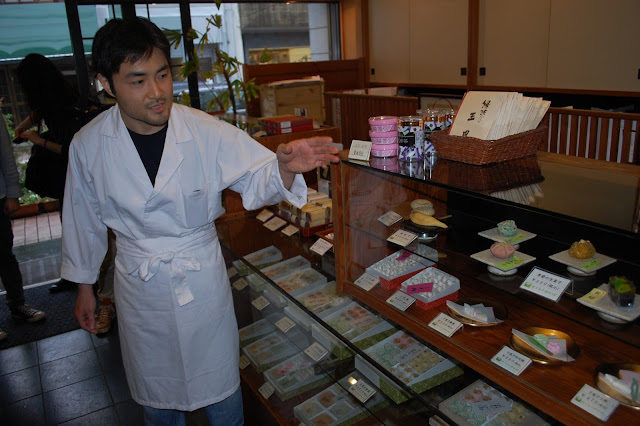Each alter is catered to the needs of the customer. They have many different types of alters. Some are Karaki-Butsudan for Zen Buddhism, Kin-Butsudan for Shin Buddhism, and others like compact alters, modern designs and many others.They can also custom design an alter or they can modify one that has been previously purchased. Many of these alters have been purchased many years ago and handed down from generation to generation which is a place to put the ashes for loved ones that have passed away.
Other items that they have are home shrine articles, Buddhist rosaries and specialty items for those that that want to leave a personal items at grave sites.
Some of these alters can be very simple and small while others can be very large and complex. It was said that the alter below took over three years to built and assemble. It was a challenging experience for the builder because of the vast details on the figures, the intricate panel design and the size of the alter.
And to give us a taste of how some of this work is done, we tried our hand at laying a gold sheet on into a bowl using the same technique that the builders use when they are restoring other alters.We first had to spread a thin layer of a type of lacquer in the bowl and let it sit for about five minutes.
After about five minutes, using tweezers, we had to pick up the gold paper and position it in the bowl so it can lay flat. There were many different types of paper to use but we used the basic gold standard.
This was kind of a tricky process only because the gold paper that we were using was so very thin and very delicate. I had some trouble laying the gold paper into the bowl evenly but after a few tries I got it down pretty good. We then used some kind of cotton material to smooth it out and polish it up. This, to, was a delicate process. If you pressed down too hard, you could tear the paper off. I was the first done in my group. I was told that I did a pretty good job for a first-timers. Even one of the gentlemen there said to me in Japanese, "For a big man, you have very delicate hands."
After we left Fujii Butsudan, we walked to a 440 year old Buddhist temple called Gifu Zenkoji.
At this temple, we were shown the proper and correct way to practice “Zazen” or silent meditation. Zazen is a way to increase concentration and focus while decreasing anxiety and stress. First, before entering the temple, we had to purify our hand and remove our shoes.
Upon entering the temple, we were shown how to sit properly (which put my legs to sleep) and how to position our arms, hands and back. Sitting flat, back straight, eyes half closed, and hands positioned near your belly button in the position of an open fist with your thumbs on top. You are to breathe slowly through our nose and exhale out of our mouth.

We performed one fifteen minute Zazen and then a ten minute Zazen. I have to admit, even though my legs fell asleep, the fifteen minutes did feel like it went by quick. And when the first Zazen was complete, my legs didn't tingle anymore. I did feel very relaxed. We did a second Zazen for ten minutes and I felt the same when it was complete, very relaxed. It was a great experience.
The area where this temple is located has very beautiful scenery.
Now that we were in a relaxed mood, it was time to visit the Okinaya Japanese Sweet Company featuring Wagashi. There we met Daisuke and Margie (from California) Hayashi (Facebook picture). Daisuke is a sixth generation Wagashi chef. Although Daisuke is a college graduate, he felt that his family business was his calling and he loves being a Wagashi chef. Founded in 1865, Okinaya has been dedicated to producing and selling Wagashi for the tea ceremony, gifts and home use for over 140 years.
So what is Wagashi you ask? Wagashi, translated as "sweets", is a traditional Japanese confectionery which is often served with tea. All the treats are made by hand, no machines. Daisuke gave us a brief background about his shop and some history about the art of Wagashi and the different types of Wagashi.
After a quick demonstration about how it is done, we gave it a shot. First, we were given our ingredients.
This is what the end product is suppose to look like.
These are how mine turned out. Not too bad I would say myself.
With our Wagashi, we were given a glass of tea. I don't remember the name of the tea but it was pretty good. We were told that it was respectful to try and finish the tea within three or four drinks. Three for me.
After everything was said and done, Dr. Laurence presented a few gifts of our appreciation.




















No comments:
Post a Comment